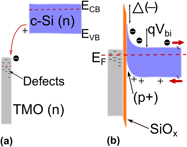Crossref Citations
This article has been cited by the following publications. This list is generated based on data provided by
Crossref.
Xiao You-Peng
Gao Chao
Wang Tao
and
Zhou Lang
2017.
Carrier selective contacts:a selection of high efficiency silicon solar cells.
Acta Physica Sinica,
Vol. 66,
Issue. 15,
p.
158801.
Sacchetto, Davide
Jeangros, Quentin
Christmann, Gabriel
Barraud, Loris
Descoeudres, Antoine
Geissbuhler, Jonas
Despeisse, Matthieu
Hessler-Wyser, Aicha
Nicolay, Sylvain
and
Ballif, Christophe
2017.
ITO/MoOx/a-Si:H(i) Hole-Selective Contacts for Silicon Heterojunction Solar Cells: Degradation Mechanisms and Cell Integration.
IEEE Journal of Photovoltaics,
Vol. 7,
Issue. 6,
p.
1584.
Tong, Jingnan
Wan, Yimao
Cui, Jie
Lim, Sean
Song, Ning
and
Lennon, Alison
2017.
Solution-processed molybdenum oxide for hole-selective contacts on crystalline silicon solar cells.
Applied Surface Science,
Vol. 423,
Issue. ,
p.
139.
Gerling, Luis. G.
Masmitja, Gerard
Ortega, Pablo
Voz, Cristóbal
Alcubilla, Ramón
and
Puigdollers, Joaquim
2017.
Passivating/hole-selective contacts based on V2O5/SiOx stacks deposited at ambient temperature.
Energy Procedia,
Vol. 124,
Issue. ,
p.
584.
Masmitjà, Gerard
Gerling, Luís G.
Ortega, Pablo
Puigdollers, Joaquim
Martín, Isidro
Voz, Cristóbal
and
Alcubilla, Ramón
2017.
V2Ox-based hole-selective contacts for c-Si interdigitated back-contacted solar cells.
Journal of Materials Chemistry A,
Vol. 5,
Issue. 19,
p.
9182.
He, Jian
Ling, Zhaoheng
Gao, Pingqi
and
Ye, Jichun
2017.
TiO2 Films from the Low‐Temperature Oxidation of Ti as Passivating‐Contact Layers for Si Heterojunction Solar Cells.
Solar RRL,
Vol. 1,
Issue. 12,
Yoon, Woojun
Moore, James E
Cho, Eunhwan
Scheiman, David
Kotulak, Nicole A
Cleveland, Erin
Ok, Young-Woo
Jenkins, Phillip P.
Rohatgi, Ajeet
and
Walters, Robert J.
2017.
Hole-selective molybdenum oxide as a full-area rear contact to crystalline p-type Si solar cells.
Japanese Journal of Applied Physics,
Vol. 56,
Issue. 8S2,
p.
08MB18.
Shokeen, Poonam
Jain, Amit
and
Kapoor, Avinashi
2017.
Embedded vertical dual of silver nanoparticles for improved ZnO/Si heterojunction solar cells.
Journal of Nanophotonics,
Vol. 11,
Issue. 04,
p.
1.
Mews, Mathias
Lemaire, Antoine
and
Korte, Lars
2017.
Sputtered Tungsten Oxide as Hole Contact for Silicon Heterojunction Solar Cells.
IEEE Journal of Photovoltaics,
Vol. 7,
Issue. 5,
p.
1209.
Almora, Osbel
Gerling, Luis G.
Voz, Cristóbal
Alcubilla, Ramón
Puigdollers, Joaquim
and
Garcia-Belmonte, Germà
2017.
Superior performance of V2O5 as hole selective contact over other transition metal oxides in silicon heterojunction solar cells.
Solar Energy Materials and Solar Cells,
Vol. 168,
Issue. ,
p.
221.
Yu, Cao
Xu, Shengzhi
Yao, Jianxi
and
Han, Shuwei
2018.
Recent Advances in and New Perspectives on Crystalline Silicon Solar Cells with Carrier-Selective Passivation Contacts.
Crystals,
Vol. 8,
Issue. 11,
p.
430.
Lin, Wenjie
Wu, Weiliang
Bao, Jie
Liu, Zongtao
Qiu, Kaifu
Cai, Lun
Yao, Zhirong
Deng, Youjun
Liang, Zongcun
and
Shen, Hui
2018.
Novel hole selective CrOx contact for dopant-free back contact silicon solar cells.
Materials Research Bulletin,
Vol. 103,
Issue. ,
p.
77.
Lin, Wenjie
Wu, Weiliang
Liu, Zongtao
Qiu, Kaifu
Cai, Lun
Yao, Zhirong
Ai, Bin
Liang, Zongcun
and
Shen, Hui
2018.
Chromium Trioxide Hole-Selective Heterocontacts for Silicon Solar Cells.
ACS Applied Materials & Interfaces,
Vol. 10,
Issue. 16,
p.
13645.
Ali, Haider
Bullock, James
Gregory, Geoffrey
Yang, Xinbo
Schneider, Matthew
Weber, Klaus
Javey, Ali
and
Davis, Kristopher O.
2018.
Transmission Electron Microscopy Studies of Transition Metal Oxides Employed as Carrier Selective Contacts in Silicon Solar Cells.
p.
2192.
Yu, Jing
Fu, Yangming
Zhu, Liqiang
Yang, Zhenhai
Yang, Xi
Ding, Li
Zeng, Yuheng
Yan, Baojie
Tang, Jiang
Gao, Pingqi
and
Ye, Jichun
2018.
Heterojunction solar cells with asymmetrically carrier-selective contact structure of molybdenum-oxide/silicon/magnesium-oxide.
Solar Energy,
Vol. 159,
Issue. ,
p.
704.
García-Hernansanz, R.
García-Hemme, E.
Montero, D.
Olea, J.
del Prado, A.
Mártil, I.
Voz, C.
Gerling, L.G.
Puigdollers, J.
and
Alcubilla, R.
2018.
Transport mechanisms in silicon heterojunction solar cells with molybdenum oxide as a hole transport layer.
Solar Energy Materials and Solar Cells,
Vol. 185,
Issue. ,
p.
61.
Mehmood, Haris
Nasser, Hisham
Tauqeer, Tauseef
Hussain, Shahzad
Ozkol, Engin
and
Turan, Raşit
2018.
Simulation of an efficient silicon heterostructure solar cell concept featuring molybdenum oxide carrier-selective contact.
International Journal of Energy Research,
Vol. 42,
Issue. 4,
p.
1563.
Lee, C.-Y.
Deng, S.
Zhang, T.
Cui, X.
Khoo, K. T.
Kim, K.
and
Hoex, B.
2018.
Evaluating the impact of thermal annealing on c-Si/Al2O3 interface: Correlating electronic properties to infrared absorption.
AIP Advances,
Vol. 8,
Issue. 7,
Black, L.E.
van de Loo, B.W.H.
Macco, B.
Melskens, J.
Berghuis, W.J.H.
and
Kessels, W.M.M.
2018.
Explorative studies of novel silicon surface passivation materials: Considerations and lessons learned.
Solar Energy Materials and Solar Cells,
Vol. 188,
Issue. ,
p.
182.
Menzel, Dorothee
Mews, Mathias
Rech, Bernd
and
Korte, Lars
2018.
Electronic structure of indium-tungsten-oxide alloys and their energy band alignment at the heterojunction to crystalline silicon.
Applied Physics Letters,
Vol. 112,
Issue. 1,






